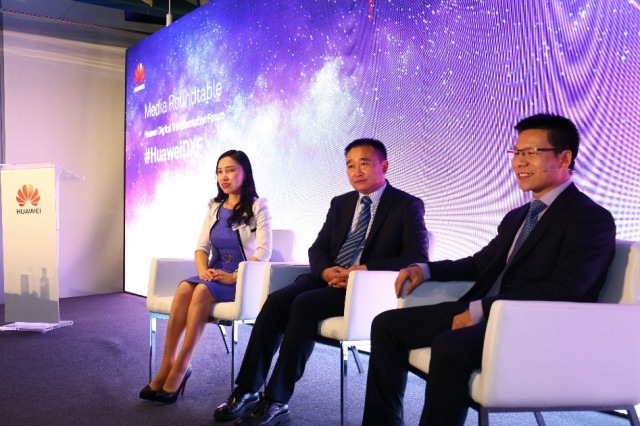Huawei Helps Emerging Markets to Accelerate Digital Upgrade
New Industry Environment, Cooperation Modes, and Business Solutions will Advance Digital Economic and Social Development
[Barcelona, Spain, February 25, 2018] At Huawei Digital Transformation Forum on the eve of MWC 2018, Huawei outlined its commitment to accelerate digital upgrade in emerging markets. Huawei will continue to cooperate with operators, local governments, and other industry partners on ICT infrastructure initiatives, expanding ecosystem partnerships to introduce new services and delivering innovative solutions that bridge the digital divide across emerging markets caused by the broadband coverage.
Access to the Internet through fixed and mobile networks will soon become a basic right. In 2017, more than 450 million people were connected to mobile Internet, and more than 30 million families had access to broadband services. However, 3 billion people in the world still lack access, and 870 million do not even own mobile phones. 1.1 billion families still do not have broadband connections. With growing mobile adoption and rising GDP per capita in densely populated emerging markets, a large proportion of income is spent on both voice and data services. This offers significant opportunities for operators. It is estimated that over the next five years, more than 1 billion people in emerging markets will be connected and the resulting traffic will increase by five to ten times.

From left to right: Dr. Hu Kangyan, Huawei President of Global Wireless Network Marketing; Zhou Jianjun, VP of Huawei Carrier Network BG; Steven Qin, President of Huawei Network Marketing Department
However, there are obstacles for operators that hinder network development in emerging markets, namely infrastructure and industry ecosystems. These factors slow revenue growth and increase the costs of network construction, operation, and maintenance.
Zhou Jianjun, Vice President of Huawei Carrier BG, said that "To capitalize on the vast opportunities in emerging markets, operators need to deliver a better scenario-based service and accelerate their return on investment (ROI). Huawei is focused on three core areas to help operators meet the burgeoning demands on their networks. We are engaging with industry partners to build open, cooperative, and win-win industry ecosystems for ICT infrastructure, and creating business solutions to help operators deliver services that generate new revenue streams while simultaneously improving the quality of life in emerging markets."
New Industry Environment
The relatively weak ICT infrastructure in emerging markets requires that governments introduce top-down top-level design and unified planning, as well as industry support in unconnected areas. Digital economic development must be driven by ICT development and opportunities in the next couple of years must be seized to bridge the digital divide. In recent years, the Malaysian government has attached great importance to the development of the ICT industry. In just three years, the proportion of digital economy in the country's GDP has risen to 17%, ranking the highest in the world.
New Cooperation Modes
Huawei cooperates with industry partners in ecosystems to promote new forms of cooperation, effectively helping to shorten the ROI of operators, and drive the positive cycle of business development and network construction. Huawei helps operators use existing public assets from governments and tower vendors to build site ecosystems, work with partners to build an FTTH industry alliance, and implement infrastructure collaboration. In 2017, over 30 infrastructure industry alliances have been established to maximize the investment efficiency of infrastructure.
New Business Solutions
Huawei is working with operators to offer a series of innovative business solutions. These are primarily introduced to increase the efficiency of network operation and maintenance, rapidly deploy broadband to the home, and fully leverage existing network and public assets to unleash site potential and maximize spectral efficiency. These solutions are already delivering benefits for operators in emerging markets:
- The CloudAIR spectrum cloudification technology maximizes spectral efficiency in India and Thailand. Unlike traditional spectrum sharing solutions, CloudAIR offers spectrum cloudification to allow different radio access technologies (RATs) to dynamically share spectrum resources. This solution enables the rapid deployment of 3G and 4G networks and releases suppressed traffic.
- The RuralStar solution is developed for remote rural areas in Africa to improve local network coverage. Approximately 80 million users have been served. 40,000 upgraded base stations are planned to be deployed later this year, serving 180 million users.
- In Mongolia, Philippines, South Africa, and Sri Lanka, wireless-to-the-x (WTTx) has provided the most cost-effective home broadband services. Over the course of one year, in Mongolia and Morocco, broadband connections are provided for 10% and 5% of families, respectively. In Saudi Arabia and Egypt, the traditional copper cables will be introduced to improve user experience.
- Mobile Money drives financial inclusion in Kenya. Operators use Mobile Money to deliver basic banking transactions and drive inclusive financial services in unbanked rural areas.
MWC 2018 will be held from February 26 to March 1 in Barcelona, Spain. Huawei will showcase its products and solutions at booth 1J50 in Fira Gran Via Hall 1, booth 3I30 in Hall 3, and the Innovation City zone in Hall 4. For more information, please visit www.huawei.com/mwc2018/.

